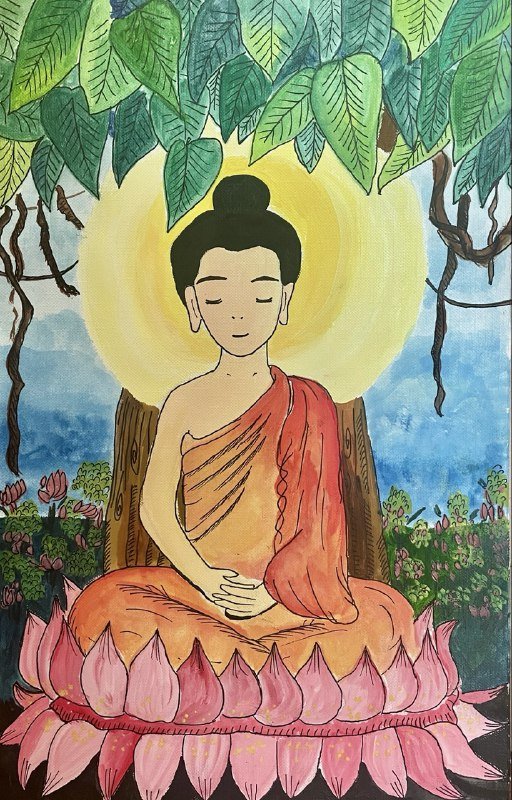
BAM Issue 1
Buddha and Avalokiteshvara images
Featuring works by: Liu Wen Chao, John Vo, Ernest Seah, Kumuda, Hui Yun
Arranged by: Ong Xiao Yun
The recollection of the Buddha is one of the meditation methods where one meditates on the qualities of the enlightened one. Among the artworks received are artists whose primary focus were on homages to the images of the Buddha and Avalokiteshvara (Guan Yin). They expressed veneration and wishes of protection for the world. A few of them also expressed inspirations from historical cave paintings and Buddha images.
A more distinct semblance to the local Singapore context is the oil painting by Liu Wen Chao. Perhaps it seemed more at ease for Bodhisattva Guan Yin to be sitting on the Kwan Im Thong Hood Cho Temple at Waterloo street, the pose known as the lalitasana (the pose of royal ease). Unlike the Sri Lanka image of royal pose, the difference is that the right hand is extended out and relaxed with palm gently facing downwards, the Sri Lanka image has the right hand bent towards the body, resting on the knee with a mudra. Wen Chao imagined that Guan Yin is looking at the devotees going to the temple for worship. His oil painting of the scenescape is detailed with the familiar scene of umbrella mobile cart stall holders who are usually stationed outside the temple selling lotus flowers, joss sticks and jasmine flower offerings to devotees. A familiar scene which we look forward to as Singapore slowly heals from Covid19. The colours are bright and inspire bliss.
I painted the Guanyin Temple in Singapore, where many Buddhists come to worship the Buddha every day. I imagined there is a Guanyin sit on top of the roof watching at those people . The reference of Guanyin image comes from the statue of Guanyin in the Liao Dynasty.
Liu Wen Chao
John Vo’s watercolour painting on paper depicts the Vietnamese image of Avalokiteshvara. Known as the Quan Am, she has countless arms and faces symbolising her protection and compassion for countless beings. John’s painting is detailed and the colours he used for the statue gives a sculptural feel to the image. Quan Am, the goddess of great compassion, is seen in a seated meditation pose on the lotus flower seat. It is interesting that the lotus seat is painted in its living fresh pink colour, which seems to suggest impermanence and a distinct separation from the statute.
In Kumuda’s homage paintings, she chooses 2 Ajanta cave paintings[1] and one of them is “Padmapani'' (lotus-hand) , an Indian image of Avalokiteshvara. Holding the lotus flower in the right hand, it symbolises great compassion and the eyes casting downwards are important qualities for Kumuda. For her, they symbolise peace, harmony and compassion for the world. Another painting, “Beggar of Wisdom” is an image of Buddha on alms giving. In both Kumuda’s paintings, she uses colour reflecting the robe of the monks. They are very beautiful paintings. I have provided a link to an audio talk by Venerable Bhikkhu Bodhi on the Rāhula Sutta in the Suttanipāta to provide a clearer view to the understanding of this image.[2]
[1] The reproductions of Ajanta Cave paintings began in the mid 19th century after James Fergusome published a report on the survey of rock-cut temples. Notable reproductions took place around mid to end 19th century by Major Rober Gill, John Griffin, James Bugess, Lady Heringham and her team
[2] https://bodhimonastery.org/sutta-nipata.html
I apologise that I am unable to link directly to the audio talk. Please click on the link, scroll down to Cūḷavagga: the Minor Chapter, the audio talk is No 4, Sn 2.11 Rāhula Sutta — Rāhula
Ernest Seah uses the technique of screen print in printmaking. The colours are bright and energetic (suggesting viriya) depicting the Buddha. “Blessing Under the Bodhi Tree” features the iconography of the standing Buddha with the Abhaya mudra (gesture). The protruding head part looks like the siraspatha which is a symbol used to indicate the five coloured rays believed to have emanated from the Buddha simultaneously with his enlightenment. Following the flow of the robes through lines, the Buddha image is defined by many small curved lines against the background of lines running in other directions. “Sunrise Meditation” features an image of the seated meditating Buddha. The Buddha is seated in a lotus position. The print suggests a kind of disintegration or the merging of the Buddha image into the background.
In Hui Yun’s watercolour and ink painting. she paints the Buddha sitting in meditation on a lotus flower seat. The Buddha is seen in a state of being in harmony and peace, framed by the environment, emitting radiance.
Consulting References:
1. Buddhist Art and Architecture, Robert E. Fisher
2. The Ajanta caves, ancient paintings of Buddhist Indian, Benoy. K. Behl






